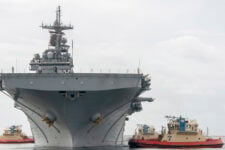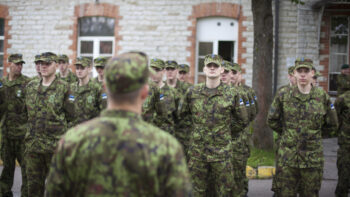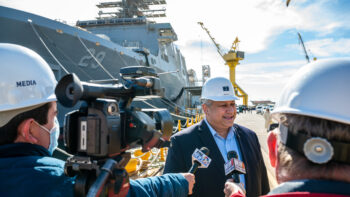 The Navy’s jet-powered P-8 Poseidon patrol plane boasts plenty of advances over the P-3 Orion turboprops it will replace, but for the sensor operators the favorite feature will be very basic: They won’t throw up as much.
The Navy’s jet-powered P-8 Poseidon patrol plane boasts plenty of advances over the P-3 Orion turboprops it will replace, but for the sensor operators the favorite feature will be very basic: They won’t throw up as much.
The P-3’s notoriously rough ride at low altitudes and the gunpowder-like stench from the launch tube shooting sonar buoys out the back meant that, “typically, every mission or two you’d have somebody get sick [and] start throwing up into their air sickness bag,” said Navy Captain Aaron Rondeau, a P-3 veteran who now runs the P-8 program. “We haven’t seen that much with the P-8.”
With its more modern and less rigid wing, “it’s a much smoother ride than the P-3,” Rondeau explained, and the buoys are now launched by compressed air, without the old system’s stink. And that just means, he said, that “If your aircrews aren’t sticking their heads in barf bags, they can do their missions better.”
Not everyone really cares whether the operators barf in the back and believe in the P-8’s higher-altitude approach. “I don’t think it will work as well,” noted naval expert Norman Polmar said bluntly. “It’s rather controversial.”
In particular, after some waffling back and forth, the Navy decided to leave off a sensor called the Magnetic Anomaly Detector (MAD), which can detect the metal hulls of submarines — if the plane flies low enough. MAD was crucial to the P-3’s traditional low-altitude tactics. Significantly, the P-8 variant that Boeing is building for the Indian Navy will still have it; only the US Navy P-8 will not. Both Rondeau and Boeing argue that the P-8 can more than compensate with more sophisticated sensors and by using its superior computing power to interpret their data.
So with the P-8, the Navy is not just replacing a sixties-vintage propeller plane with a more modern jet, derived from the widely used Boeing 737. It’s also betting on new technology to enable a high-altitude approach to both long-range reconnaissance and hunting hostile submarines.
Traditional “maritime patrol aircraft” like the P-3 spend part of their time at high altitude but regularly swoop down, sometimes as low as 200 feet above the waves, to drop sonar buoys, scan for subs with the magnetic anomaly detector, launch torpedoes, and simply eyeball unidentified vessels on the surface. But jets like the P-8 are significantly less fuel-efficient at low altitudes than turboprops like the P-3.
“There’s a misconception,” said Rondeau. “Some people think that that means P-8 can’t do low-altitude anti-submarine warfare [ASW]. We can, and it’s very effective down low, [but] we will eventually get to the point where we stay at higher altitudes.”
For some of the new sub-hunting technologies, Rondeau argued, going higher actually gives you a better look. Today, for example, one key tool is a kind of air-dropped buoy that hits the water and then explodes, sending out a powerful pulse of sound that travels a long way through the water and reflects off the hulls of submarines, creating sonar signals that other, listening-device buoys then pick up. (The technical name is Improved Extended Echo Ranging, or IEER). Obviously, an explosive buoy can only be used once, and the sonar signal its detonation generates is not precisely calibrated. So the Navy is developing a new kind of buoy called MAC (Multistatic Active Coherent), which generates sound electronically, allowing it to emit multiple, precise pulses before its battery runs down.
“It will last longer and you’re able to do more things with it,” Rondeau said. And because a field of MAC buoys can cover a wider search area, he said, “we need to stay up high… to be able to receive data from all these buoys and control all these buoys at the same time.”
An early version of MAC will go on P-3s next year and on P-8s in 2014, but only the P-8 will get the fully featured version, as part of a suite of upgrades scheduled for 2017. The Navy is deliberately going slow with the new technology. Early P-8s will feature systems already proven on the P-3 fleet and will then be upgraded incrementally. The P-8 airframe itself is simply a militarized Boeing 737, with a modified wing, fewer windows, a bomb-bay, weapons racks on the wings, and a beefed-up structure.
This low-risk approach earned rare words of praise from the Government Accountability Office, normally quick to criticize Pentagon programs for technological overreach. “The P-8A,” GAO wrote, “entered production in August 2010 with mature technologies, a stable design, and proven production processes.” (There have been issues with counterfeit parts from China, however).
“We had to have this airplane on time,” Rondeau said: The P-3s were getting so old, and their hulls are so badly metal-fatigued, that they were all too often grounded for repairs.
So far, Boeing has delivered three P-8As to the training squadron in Jacksonville, Florida. They were preceeded by eight test aircraft, some of which have just returned from an anti-submarine exerise out of Guam. The first operational deployment will come in December 2013, to an unspecified location in the Western Pacific. There the Navy will get to test its new sub-seeking techniques against the growing and increasingly effective Chinese underwater force.
Fincantieri acquires Leonardo’s undersea armaments business worth up to $447 million
Terms of the acquisition include the shipbuilder paying a fixed fee of €300 million ($323 million), and “based on certain growth assumptions,” an additional €115 ($124 million) directly relating to performance of the underwater armaments business this year.



























